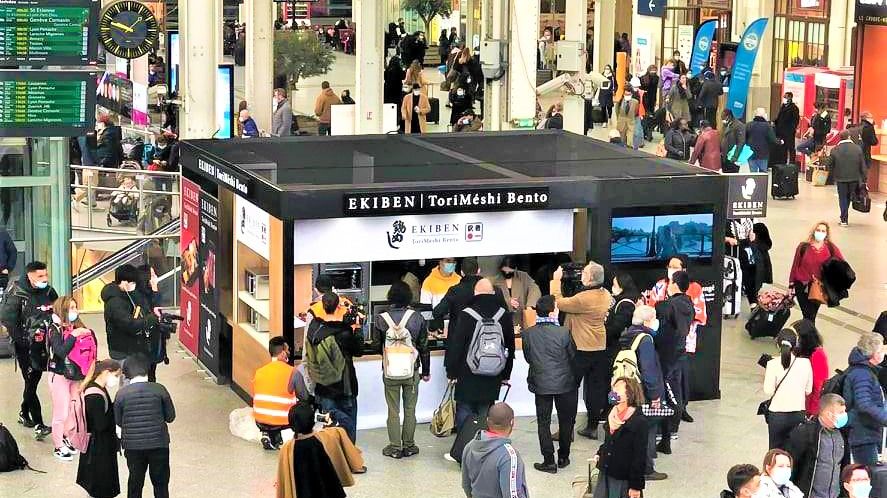
“Ekiben” Station Lunchboxes Taking Root in Paris, the City of Haute Cuisine?
Culture Food and Drink Travel- English
- 日本語
- 简体字
- 繁體字
- Français
- Español
- العربية
- Русский
Akita Torimeshi Takes France
On the morning of November 5, 2021, an unfamiliar scene unfolds in Paris’s famed Gare de Lyon, on the banks of the Seine.
In front of one platform, crowded with passengers waiting to board long-distance or international trains, stands a shop bearing a striking logo and the words Ekiben ToriMéshi Bento. Staff members wear bright red happi, the thin festive jackets that are a hallmark of events in Japan. The sight arrests the passing Parisians on their way to work or travel, and luggage-loaded tourists as well. Fascinated passersby all stop to take pictures, and many crowd around to peek into the showcase and admire the colorful food revealed. Those who have bought an ekiben quickly step over to the microwave next to the cash register to heat up their lunch.
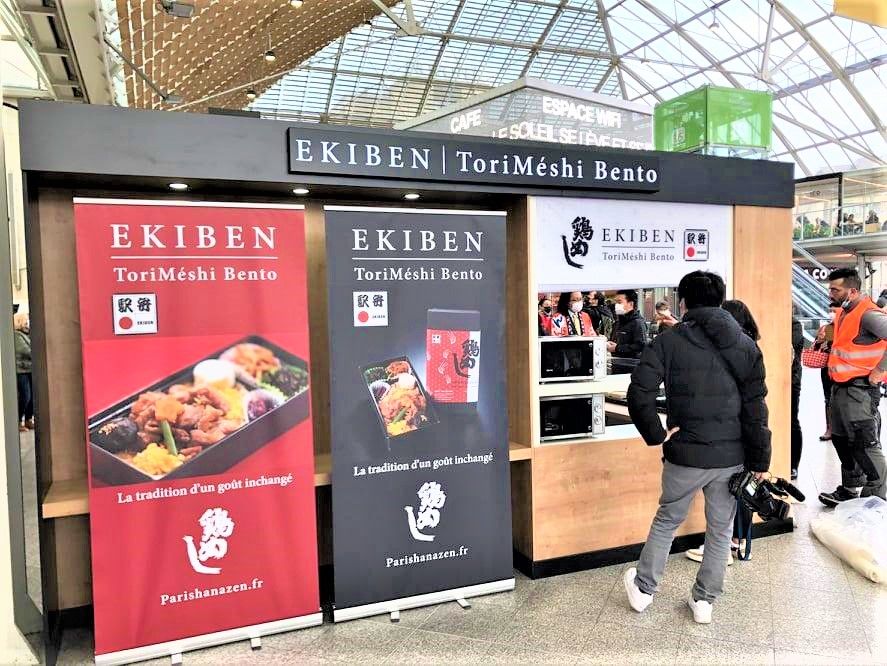
Striking torimeshi banners stand next to the shop’s microwave. © Hanazen
Japanese cuisine, or washoku, has garnered worldwide attention since its 2013 UNESCO Intangible Heritage listing. Bento, a popular Japanese-run lunch box specialist, now has around 70 locations in Paris, but only the most clued-in Japan fan is aware of the world of ekiben. Now, though, all 200 ekiben prepared for the day at Gare de Lyon sell out by 5:00 pm. “France might be at the bleeding edge of fashion, with the Paris Collection and all, but it still respects older culture. It’s fertile soil for ekiben culture to take root,” says Hanazen President Yagihashi Shūichi, who took it upon himself to go out and attract customers. The work seems to be paying off.
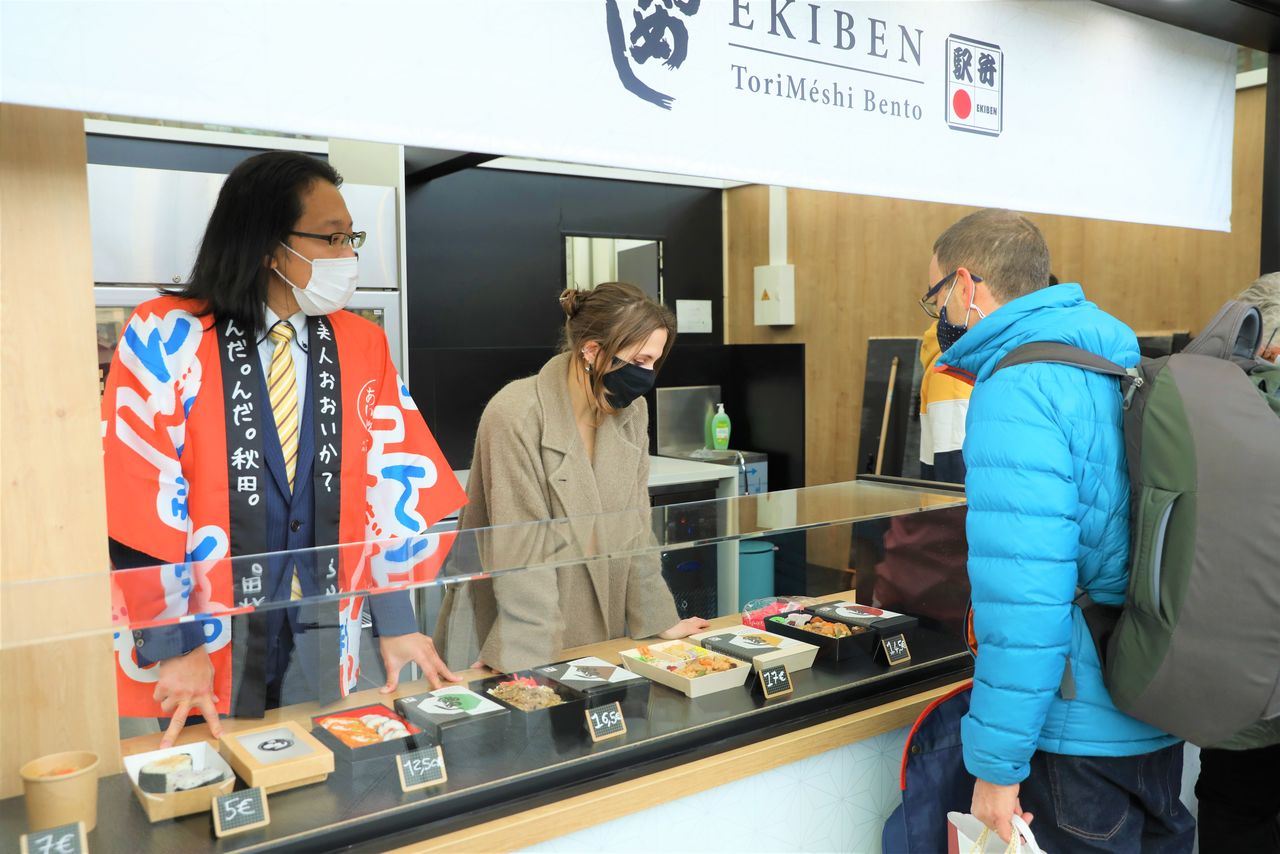
Travelers decide on their ekiben with explanations from French staff. President Yagihashi looks on in his happi. (© Hanazen)
“Long Life” Ekiben from a 120-Year-Old Shop
Hanazen’s roots go back to the Hanaoka Ryokan, a traditional inn that once stood in front of Ōdate Station. Hanaoka started a bentō box production and sales department in November 1899, after the Ōu main line station opened. In 1946, while the firm was run by Yagihashi’s grandparents Hanaoka Saburō and Uta, the bentō department was spun off into its own company, Hanaoka Shōten, and then changed its name to the current Hanazen in 1976. Yagihashi became the eighth generation of his family to run the company in 2012.
Torimeshi, literally “chicken rice,” is quite simply that: chicken and rice. It has become one of the country’s most popular ekiben dishes. It can be traced back to 1930. At the time. Hanazen made kiritanpo meals for sale on board trains by request of the Ministry of Railways. Kiritanpo refers to a local hotpot dish made from tubes of pounded rice, chicken, and vegetables in broth. As the word hotpot might imply, the dish was best served warm, and the flavor tended to degrade as it got cold in the bentō, leading to lower sales and leftover food. Of course, it would be a waste to simply throw the leftovers away. The staff would take out the chicken meat, stew it in a sweet-spicy sauce, and eat it themselves.
Eventually, during World War II, Hanazen was requisitioned to distribute rations to local residents. One day, the usual shipment of gobō burdock root, sugar, soy sauce, and rice showed up. Normally, the kitchen staff would have grated the gobō and steeped it with sugar and soy sauce to eat with steamed rice, but Hanaoka Uta felt it was too much trouble, and mixed everything together to cook with the rice. The result was a totally new, and delicious, version of takikomi-gohan mixed rice they called chameshi: brown rice.
When they started selling ekiben again in 1946, Uta thought of topping their chameshi with the staff’s secret chicken recipe, and in 1947 torimeshi went on the market. They could barely keep up with sales. The Ōu main line primarily served overnight trains up until the opening of the Ueno-Morioka stretch of the Tōhoku Shinkansen line. When trains stopped at Ōdate station, staff would sell ekiben through the windows by hand, but Yagihashi says, “Grandmother told me that customers would just throw the money out, and after the train left, she’d have to gather it up with a dustpan.”
Ekiben sales dropped with the new shinkansen line, but the shop then expanded into department stores, supermarkets, and tour bus sales. They gathered more regular customers, and in a popularity ranking of all the ekiben sold on JR East lines, Hanazen took the top spot two years in a row, with its torimeshi bentō in 2015 and a version featuring local free-range chicken in 2016. It also took the industry’s first silver medal at the global gourmet award show Monde Selection.
Even now, 70 years after the dish’s invention, torimeshi bentō are made the same way as ever. There is no mechanization. Each bentō is filled by hand, one by one. The traditional recipe that Yagihashi inherited from his grandmother still lives in the torimeshi served at Gare de Lyon.
“The flavor hasn’t been adapted at all for French tastes. I mean, if French tourists went to Japan and found the torimeshi there tasted different, they’d surely not be happy.”
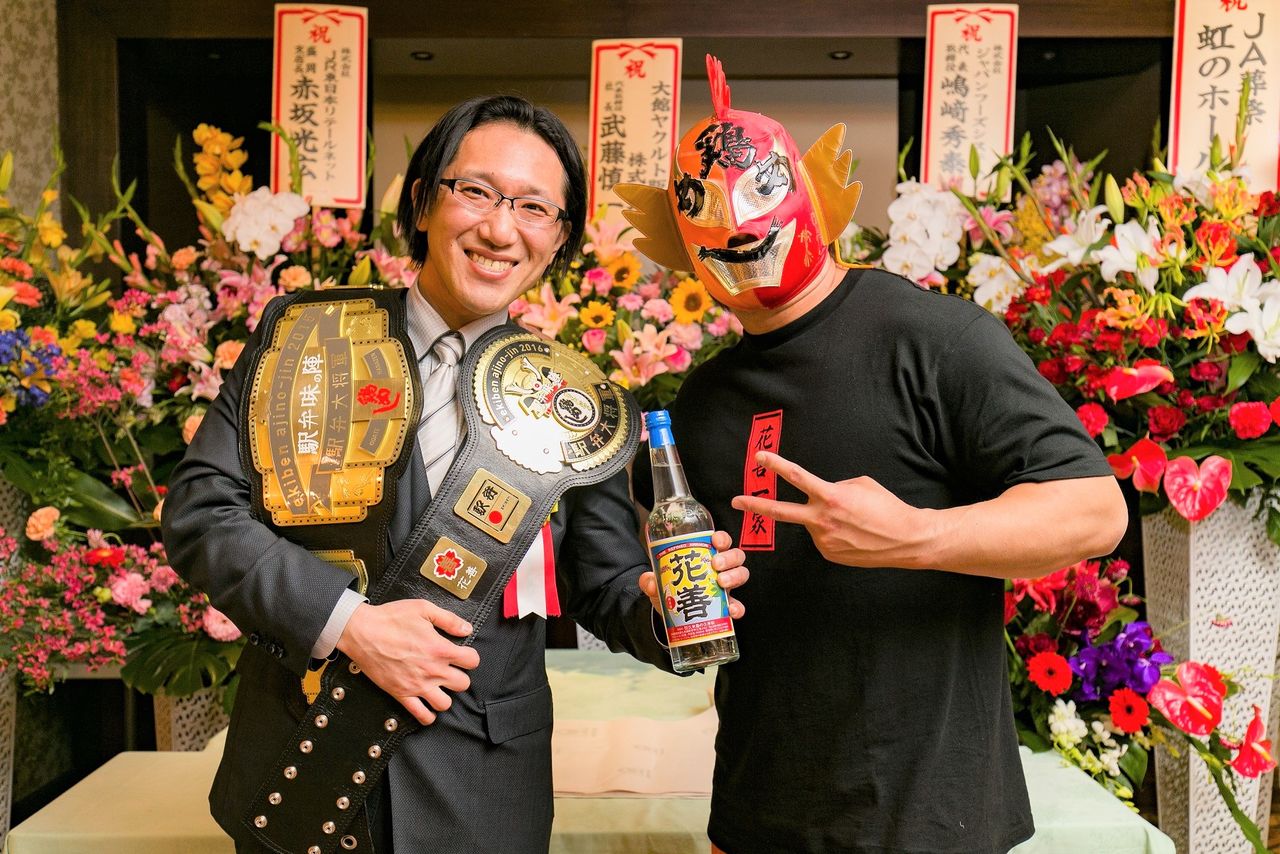
Yagihashi, the grandson of fifth-generation head Hanaoka Uta, was born and raised in Tokyo. When he was 20, unemployed and unambitious, Uta told him, “I want to open a branch in Tokyo, so come train for a year in Ōdate.” He has lived in Ōdate ever since. He once worked with a professional wrestling group, and he ordered the champion’s belts on his shoulder to commemorate the company’s ekiben titles. (© Hanazen)
Granting Wishes for the Youth of Akita
So, how did he end up selling ekiben in Paris? Apart from Yagihashi’s desire to spread ekiben culture around the world, there is another problem common to all the cities in Japan’s less populated regions that drives him.
Yagihashi has been giving lectures to elementary and junior high school students from all 27 schools in the city of Ōdate every year for the past nine years, as part of the city’s Hometown Career Education program. Whenever he asks the students about their future goals or dreams, the answer always seems to include leaving for Sendai, the capital city of neighboring Miyagi Prefecture, or Tokyo. Of course, there’s nothing wrong with heading to the city. The problem lies in the reason most give for doing so: “Even if I stayed here in Akita, what could I do?” It isn’t just the local children who think that way; many of those running local business feel the same.
Yagihashi, who was born in Tokyo and lived there until he was 20 despite his Akita roots, feels differently. “I’m really an outsider here, so I had to do a lot of studying up on Akita to be able to fit in. If whatever you want to learn can only be learned in Tokyo, then go. The place you have to go all depends on what you want to do,” he says, then adds, “If a familiar local company expanded overseas, that might encourage the local children to look to the world, too.”
And so, if he was going to sell ekiben abroad, then where? He decided that it would have to be Paris. The city has six terminal stations, and five of those—including Gare de Lyon—are European Union hubs for long-distance and international trains. There are always business travelers and tourists from Britain, Germany, Italy, and Spain. But more than anything, France is a farming nation, guaranteeing plenty of ingredients for the company’s ekiben.
Then, in autumn of 2018, just as he was getting his idea formulated, the planners of the Franco-Japanese cultural and artistic exchange event Japonisme 2018 announced they would hold an ekiben sales event at Gare de Lyon. Hanazen jumped at the opportunity to take its famous torimeshi to France.
Blocked by the 4º Wall
The EU has strict controls on importing meat, fish, eggs, and dairy products, and Hanazen could not bring in Japanese chicken, so all the chicken in the torimeshi sold at Gare de Lyon is grown in EU countries, including France. That offers no problem in terms of flavor. In fact, the Monde Selection judges even commented, “European chickens raised freely on wide open farms certainly taste better than Japanese chickens.” Japan tends to have much softer water than France, but those issues can be solved by simply cooking with more water.
The biggest barrier was the “4º wall.” In France, the rules for selling sandwiches also apply to boxed lunches, and state that they must be stored and sold at 4º Celcius or lower. Japan’s convenience stores typically keep lunches at 18º, while the ekiben industry rule is 25º. Rice is simply too hard at 4º.
Installing a microwave to heat the bentō at sales points can help, but that won’t solve everything. Indeed, many French people seem opposed to microwaving things. Since cooling the rice dries it out, they also had to cook it with increased water from the start, as well. Essentially, the shop had to make everything so it tasted best when it’s cooled down, not when fresh.
Hanazen had to put in a lot of trial and error, but in the end the month-long sales event was a success. The company prepared 1,500 ekiben and sold 1,425 of them.
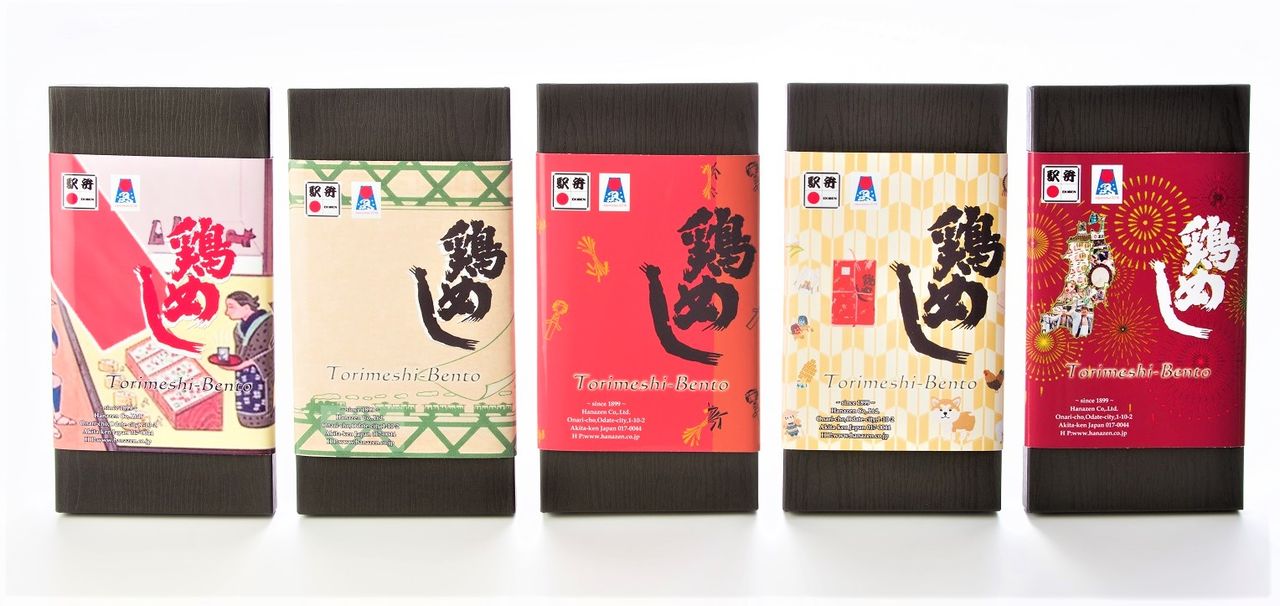
Hanazen brought five different labels to the 2018 event at Gare de Lyon. All were designed to appeal to French tastes. (© Hanazen)
One thing the firm discovered was that French customers preferred the flavored takikomi-gohan to white rice. “For most overseas diners, not just French people, sushi is the gateway to Japanese cuisine, which means they eat the rice with soy sauce. So, from that perspective, the rice in our torimeshi is already flavored with soy sauce and sugar. People actually complimented us on our great idea, since they didn’t have to add any soy sauce.”
Encouraged by the warm reception, Yagihashi set up a branch office in central Paris from July 2019 to start making and selling bentō in the runup to opening an ekiben shop. It was not long before the COVID-19 pandemic struck, but surprisingly bentō sales actually went up. In July of this year, Hanazen handily won a French National Railway competition, and finally was able to open a shop inside Gare de Lyon.
Fascination with Akita Cuisine
Now, even after a month of business, torimeshi sales are growing, and they sell out day after day.
However, a totally unexpected problem has arisen. Despite originally intending to offer 300 ekiben a day, staff are currently unable to make more than 250, and they are missing out on more and more customers.
Following grandma Uta’s lesson that “ekiben size has to be small enough to hold in one hand while you eat,” Hanazen’s are relatively compact. Staff have no problem packing the “stacked type,” with food laid atop rice, but more complicated makunouchi portioned lunch boxes, where dishes are all in different pockets, are another story. It also takes time to attach the kakegami labels.
Among the six different varieties, the relatively expensive Akita bentō, coming in at €17 is the second most popular after torimeshi. It combines several traditional Akita delights like kiritanpo and iburigakko smoked daikon alongside torimeshi. Yagihashi is glad that customers are interested in Akita flavors, but in truth this is the most difficult bentō to pack.
“We still have a whole mountain of issues to get past,” he says with a wry grin, but at the same time his face glows with fulfillment at his success as an ekiben culture evangelist.
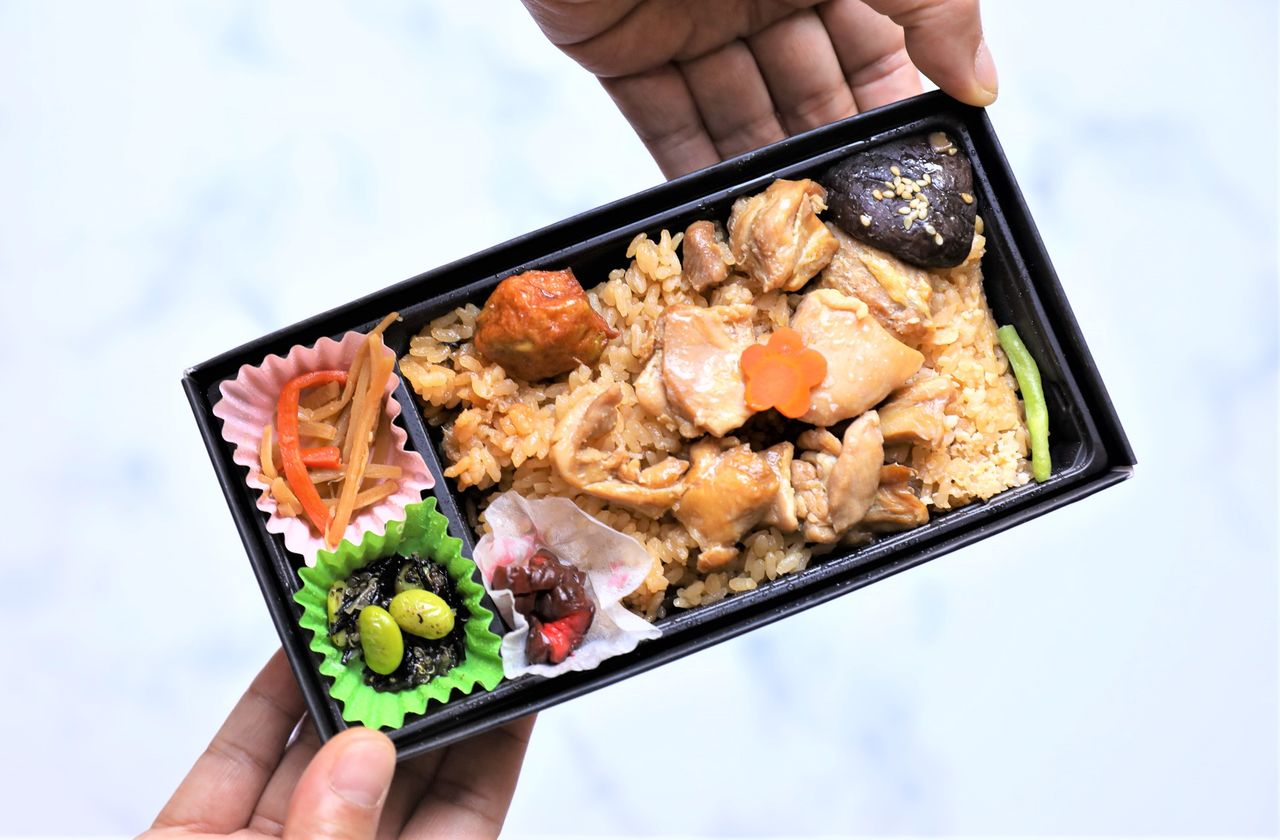
The torimeshi bentō makes up fully half of all sales (€14.50). The rice variety is Akita Komachi. The chicken is all Europe-grown due to EU regulations, but the shop has been able to re-create about 80% of the original Japanese flavor. French diners also seem to like the kinpira gobō stewed burdock root salad. (© Hanazen)
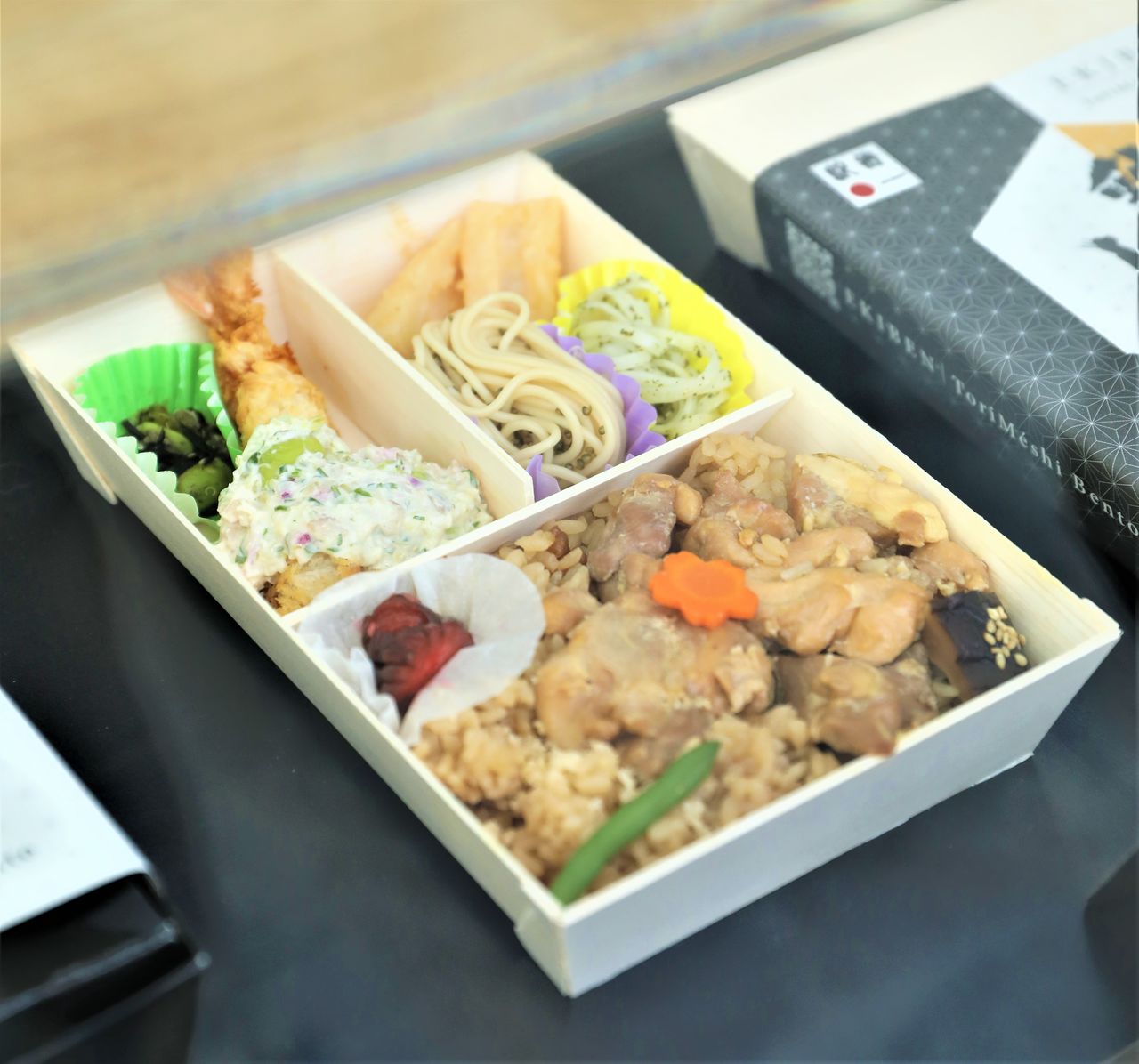
The Akita bentō, featuring a selection of local Akita dishes, is a new product made at the request of the prefecture. It has delicacies like kiritanpo with dengaku miso, Akita’s original inaniwa udon noodles, and iburigakko smoked daikon. (© Hanazen)
Courage, and a Little Money
“It isn’t all that hard to expand overseas. All you need is courage, and a little money,” says Yagihashi. In fact, the local Paris subsidiary was established with modest capital of €10,000, of which Yagihashi himself and the company each provided half.
Yagihashi has decided not to return to the bentō shop once his six months at Gare de Lyon are up. He is now preparing to start distributing torimeshi as an ekiben producer to shops at stations all over Paris. At the same time, he checks the website of the French National Railway every day, looking for a facility opening offering a seven-to-nine-year lease.
Yagihashi says he wants to make the words ekiben and torimeshi part of Parisians’ lexicon, and once the pandemic subsides, for his French customers to decide they want to try the dish on its home turf and go to Ōdate themselves. When that day comes, the children of the city will surely welcome them with a warm “Bonjour!”
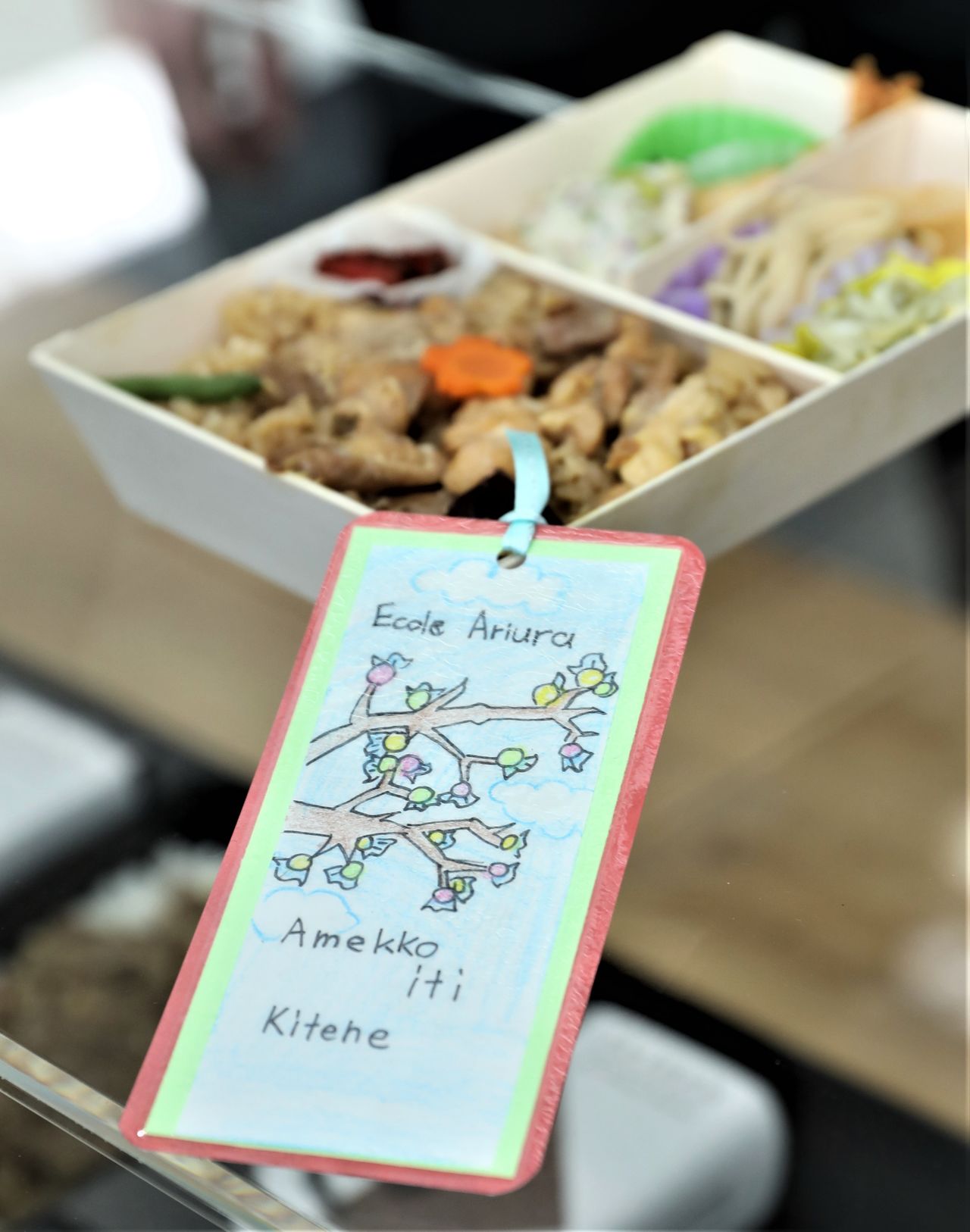
Many local Akita residents put their hearts into this project. Customers buying the Akita bentō also get a bookmark made by Ōdate elementary school students. Junior high students developed the tea to pair with torimeshi, while high school students made the menus. Students at Akita International University chose French language product names and planned the video that runs in the shop. (© Hanazen)
(Originally published in Japanese. Banner photo: Gare de Lyon in Paris is the starting point for trains heading to southern France, as well as Italy and Switzerland. It’s an ideal spot for a bentō shop. © Hanazen.)